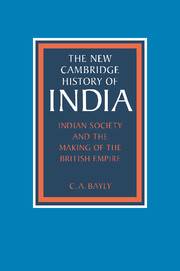Book contents
- Frontmatter
- Introduction
- 1 India in the eighteenth century: the formation of states and social groups
- 2 Indian capital and the emergence of colonial society
- 3 The crisis of the Indian state, 1780–1820
- 4 The consolidation and failure of the East India Company's state, 1818–57
- 5 Peasant and Brahmin: consolidating ‘traditional’ society
- 6 Rebellion and reconstruction
- Conclusion: the first age of colonialism in India
- Glossary of indian terms
- Bibliographical essay
- Index
- THE NEW CAMBRIDGE HISTORY OF INDIA
- Plate Section"
- References
2 - Indian capital and the emergence of colonial society
Published online by Cambridge University Press: 28 March 2008
- Frontmatter
- Introduction
- 1 India in the eighteenth century: the formation of states and social groups
- 2 Indian capital and the emergence of colonial society
- 3 The crisis of the Indian state, 1780–1820
- 4 The consolidation and failure of the East India Company's state, 1818–57
- 5 Peasant and Brahmin: consolidating ‘traditional’ society
- 6 Rebellion and reconstruction
- Conclusion: the first age of colonialism in India
- Glossary of indian terms
- Bibliographical essay
- Index
- THE NEW CAMBRIDGE HISTORY OF INDIA
- Plate Section"
- References
Summary
Europeans had been domesticated into the Indian scene since the early seventeenth century. Like the great Arab, Asian and Jewish trading communities, the Europeans – Portuguese, Dutch, French and English – were attracted to the Indian trade by her fine manufactures of cloth and silk and her agricultural raw materials, notably indigo, pepper, cardamum and other spices. Around their coastal settlements, particularly Portuguese Goa, Europeans already exercised considerable local influence in the wars and politics of the maritime states. However, under the great Mughals their trade had even begun to affect the inland economy in one important respect. Europeans paid for their commodity purchases in silver bullion from the New World, in Japanese copper and sometimes in gold. Precious metals were only found in India in small quantities, yet India's revenues and much of her rents were paid in cash. Europeans therefore filled an important function in providing the raw materials for the coin which made the internal economy – indeed the Mughal hegemony as a whole – function smoothly. In this sense India was already linked to and partly dependent on the European world economy from earlier than was once thought.
The European rôle did not begin to grow significantly until the war of the Austrian Succession, 1744–7. In their attempt to destroy each others' trade and political influence on the southern (Coromandel) coast, the English and French East India Companies became embroiled in the factional conflicts between Muslim military leaders, and these intensified following the death of the Nizam of Hyderabad, Asaf Jah, in 1748.
Keywords
- Type
- Chapter
- Information
- Indian Society and the Making of the British Empire , pp. 45 - 78Publisher: Cambridge University PressPrint publication year: 1988



